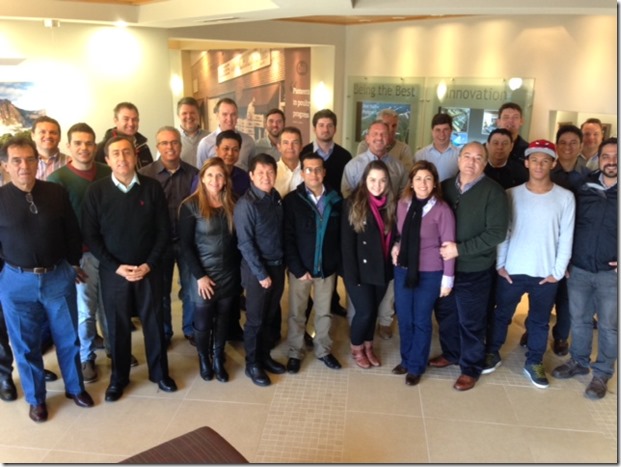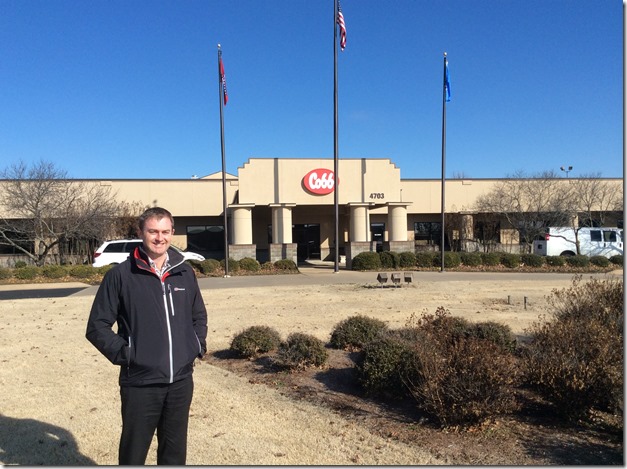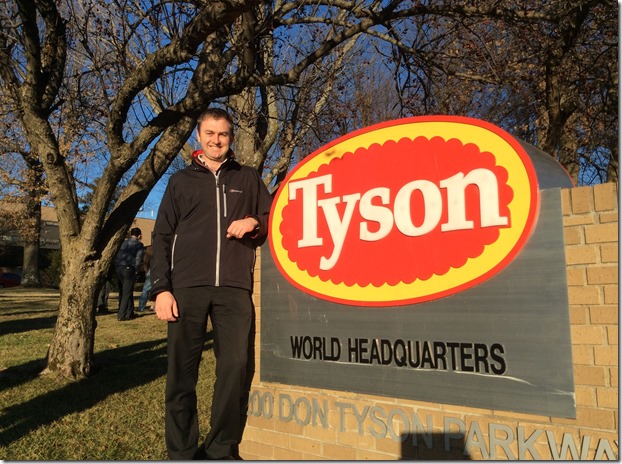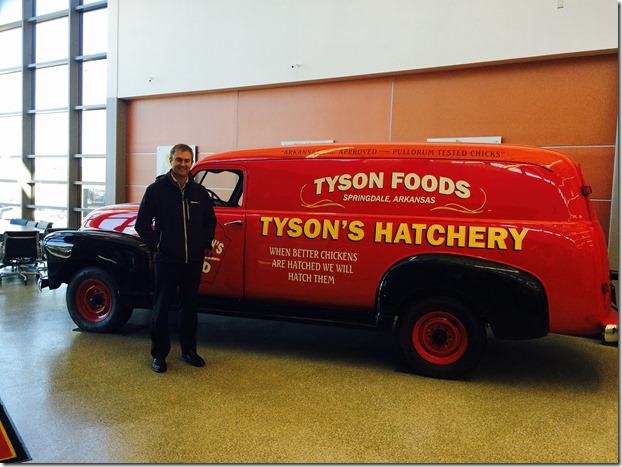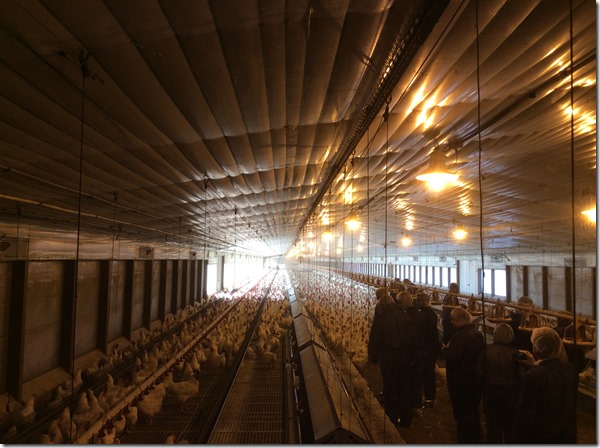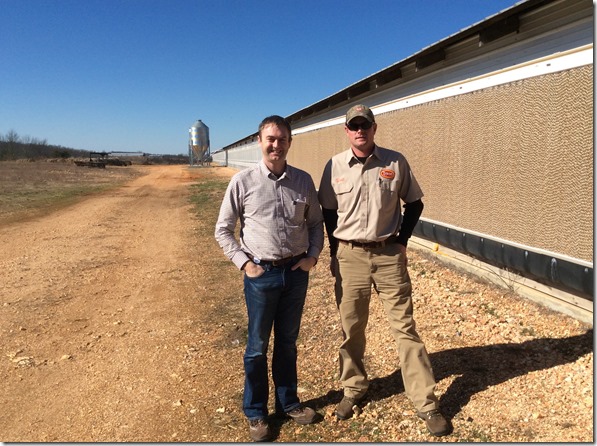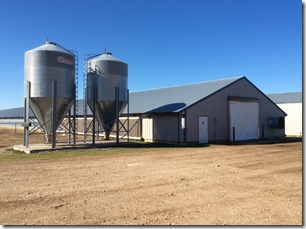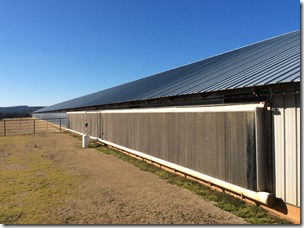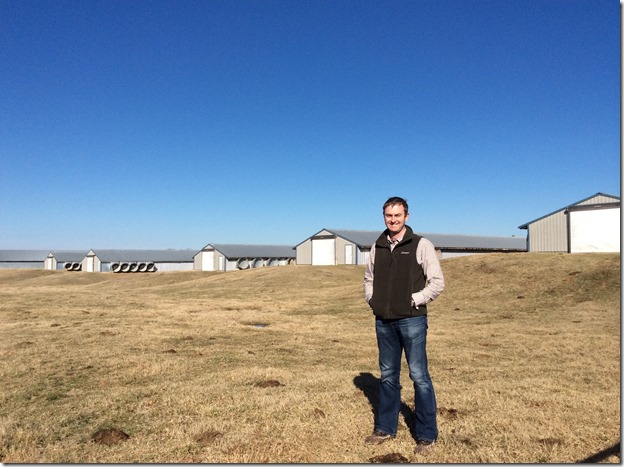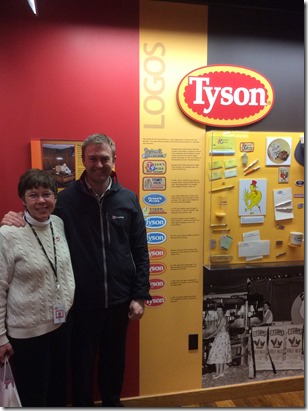Following the International Production and Processing Expo (IPPE) in Atlanta I travelled to Northwest Arkansas. This area is one of the largest poultry farming areas in the USA and is home to Tyson Foods and Cobb-Vantress. Cobb is one of the sponsors of my Nuffield Scholarship and I was invited to join their two day Post-IPPE tour. Tour delegates were looked after by Gail Thorp and she made every effort to make our visit as enjoyable as possible. Our group was made up of poultry producers from Brazil, Colombia, Venezuela, the Philippines and the UK. I had the opportunity over these two days to talk to the other delegates and this gave me an insight into how birds are reared in these countries and what challenges the industry in these countries face.
Above: Post IPPE tour delegates
We started the tour on day one with a visit to the Cobb-Vantress Corporate Office in Siloam Springs. We were welcomed by the President of Cobb-Vantress, Jerry Moye, who gave us an overview of the poultry market in the USA and how the industry is changing. Jerry explained to us that Cobb’s main strength has been, and will continue to be, selecting broiler genetics that allow their customers to operate successful businesses. Cobb was founded in 1916 and now, about half of the broiler genetics used in the world is Cobb. There have been big changes in broiler genetics companies over the past 30 years. In 1981 there were 26 broiler genetics companies world-wide whereas today there are only 3 left.
Above: Cobb Headquarters
Each year Cobb spends a lot of money on research and development as this drives their business. During the visit we were shown how the selection process has helped improve the genetics of the birds used commercially today. There has been a consistent improvement in how breeders and broilers have been performing. Each year two feed conversion points are taken off the amount it takes to produce a kilo of meat. Each year the breeders are also producing one more egg per hen. Someone raised the question how much more improvement are we likely to see, and the answer was that there has not been any sign of these improvements slowing down yet. It was very interesting to learn that chickens are the best converting farmed animals and also that they drink the least amount of water per kilo of meat produced.
I was interested to hear how genomics are used to help select the best birds to use in the breeding programme. Genomics is the use of DNA sequences to gather more data for the selectors. One blood sample gives about 60000 different DNA sequences that can be used to pick birds that would otherwise appear identical. This helps to identify the sequences that suggest the desired traits.
Future Trends in the poultry industry
Two very interesting facts I learned at Cobb is that currently breeder flock placements are increasing at the rate of about 5% per year, which suggests that the industry is in a healthy state. Broiler birds in the USA are also being grown to a heavier weight and the trend is for weight to increase by about 5% per year.
Customers in the USA are becoming increasingly aware of where their food comes from and how it was produced. There is a worldwide concern about the emergence of antibiotic resistant bacteria. Reducing antibiotics used in farmed animals is high on the agenda in several countries and Cobb is working very hard to help their customers meet antibiotic reduction targets. Cobb is also aware that there are new and emerging diseases that are becoming a problem to poultry producers.
In order to meet these demands Cobb is putting a big focus on selecting birds with good intestinal health. This is a difficult area to identify as it happens inside the birds and cannot easily be measured. Rearing birds with better intestinal health is important because:
· Worldwide raw materials are becoming more expensive and variable in quality so there is increasing emphasis on using alternative ingredients.
· There is likely to be a lot of future changes in nutritional programmes which will put additional pressure on the intestinal tract.
· The lack of antibiotics will make it harder to maintain intestinal health as the birds’ immune systems will have to work harder to keep the birds healthy.
· As energy prices are also set to increase the emergence of sub optimal growing conditions will become more common which means the gut of the birds will be under a lot of pressure.
Researchers are accepting that the relationship between gut health and food safety is increasing. This led me to ask if Cobb is doing work on selecting birds that are resistant to Campylobacter. The reply was that it is difficult to achieve. If you select a bird that puts all its energy into being resistant to one pathogen then it will inevitably be more susceptible to other pathogens. The aim is therefore to select birds that have good intestinal health as this will help the birds to grow well and be healthy. Healthy birds will indirectly be less susceptible to bacteria like Campylobacter. It is also hard to select for pathogen resistance on pedigree farms as the high levels of biosecurity on these farms are there to keep pathogens out of these birds. The information gathered on commercial farms is the only way to link areas such as pathogen resistance back to the pedigree flocks.
Spending time at the Cobb headquarters gave me renewed faith that chicken is well placed to provide a growing world population with healthy and affordable protein. Because of the work that Cobb does we stand a better chance of meeting the future demand for protein.
Tyson Foods
After lunch we visited the Tyson Discovery Centre and Tyson Founder’s Museum in Springdale, AR. Tyson Foods is the parent company of Cobb-Vantress and is the largest broiler producer in the world. Tyson processes about 42 million broilers per week in the USA. This is more than double the total amount of broilers processed in the whole of the UK each week. The Discovery Centre is the place where new products are developed and existing ones are improved. It is also where packaging is developed and sensory testing is done on consumer panels. Chefs at the Discovery Centre work very closely with customers to produce products that keep Tyson products in demand and on retailers’ shelves. There are 19 test kitchens and a USDA inspected pilot processing plant where lots of the research is conducted.
Above: Outside the Tyson Headquarters
Above: One of the original Tyson delivery vehicles
Green Forest Complex
The following day we visited the Tyson Green Forest Complex located about 1 and a half hours drive east of Fayetteville. We started the day with a visit to the hatchery which hatches about a million chicks per week. Through the day we also visited a breeder and a broiler farm and the processing plant for the complex.
After visiting the hatchery we visited one of the hatchery’s supply farms located near Harrison, AR.
The owner of the farm is Tim Creamer and he has one breeder house with 13100 birds. He has two sons in the business and is looking to expand the business by building a second breeder house later this year. The farm was very well run and we were allowed to quiz Tim on how he manages to have 90% hatchability from his eggs. I got the impression that a lot of his good performance is down to attention to detail and good management.
Above: Breeder house on the farm of Tim Creamer
I was interested to hear how Tim uses a biological treatment to keep flies under control. He buys wasp eggs which get spread in the litter under the slats. When the wasps hatch, they feed on fly larvae and so keep fly numbers under control in the warm summer months.
A point of interest to me is that all the Tyson field staff wears khaki clothing with their first name embroidered on their shirt. Don Tyson’s philosophy was that everyone is equal and that you should be able to call your manager by his first name. The official uniform of Tyson in Don’s day was a khaki shirt and trousers and this has continued after his death in 2011.
Above: Werner Strydom & Scott Sizemore (Tyson Foods)
After lunch we visited South Wind Farm near Berryville, AR. The farm is made up of 10 broiler houses and the business is owned by John Wilson. This was my first visit to a broiler farm in the USA and I was very interested to see how broilers are produced on deep litter systems. Temperatures can reach in excess of 40oC in summer so all broiler houses are fitted with evaporative cooling pads and tunnel ventilation. The houses tend to be between 30 and 40 feet wide to increase the speed of the air in summer. This high speed amplifies the wind chill factor which ensures that the birds stay comfortable in hot weather. Sheds can be up to 600 feet long so tunnel ventilation works very well. Before entering the poultry houses we were kitted out in coveralls and boot covers. We were also given hairnets and plastic gloves to wear. Upon entering the anteroom it was noticeable how little complication there was compared to the usual anteroom in the UK. There was a single computer controlling the house environment and a Dosatron where vaccine and vitamins can be administered. There was a single house card that held all the information recorded about the flock including mortality.
Above: Left – Broiler house on South Wind Farm; Right – Evaporative cooling pads
Generally there are no routine vaccines used on broiler farms in the USA. Should there be an issue with a poultry virus, affected areas will be vaccinated to help bring the issue under control. The birds we saw were part of an antibiotics free programme so no antibiotics were administered at any point in the birds’ lives. Should antibiotics be required for welfare reasons these birds would be marketed as standard chicken.
Above: South Wind Farm
Deep litter system
Not having seen deep litter systems before I was surprised by how “normal” the litter in the houses was. I was expecting to see the litter a lot deeper but the litter did not appear much different to the litter in an average UK broiler house. The sheds are normally washed down once per year and the wash water is washed onto the spent litter. After the sheds have been washed the litter is removed and is usually spread on land as a fertiliser. It is amazing how much less waste is produced compared to the UK where the litter is removed at the end of each flock. There is also a fraction of the wash water to dispose of.
Financial margins in the broiler industry are very small so the cost of production needs to be kept very low to ensure that the business remains viable. The capital cost of housing is significantly lower than in the UK due to their lack of complexity. There is a lot to be said for keeping it simple. Broiler farming in the UK can often be overcomplicated and people forget that all you need to rear a chicken is food, water and fresh warm air.
I am very grateful to Tyson for allowing us access to their facilities for the day. It was very impressive to see on what scale broilers are produced in the USA. I found it extremely interesting and appreciated the openness of all the staff we spoke to during the day. I am also very thankful to Cobb for inviting me to join their tour and for all the work Gail Thorp put in to organising my visit to Northwest Arkansas.
Above: Gail Thorp (Cobb-Vantress) & Werner Strydom at Tyson Founder’s Museum

